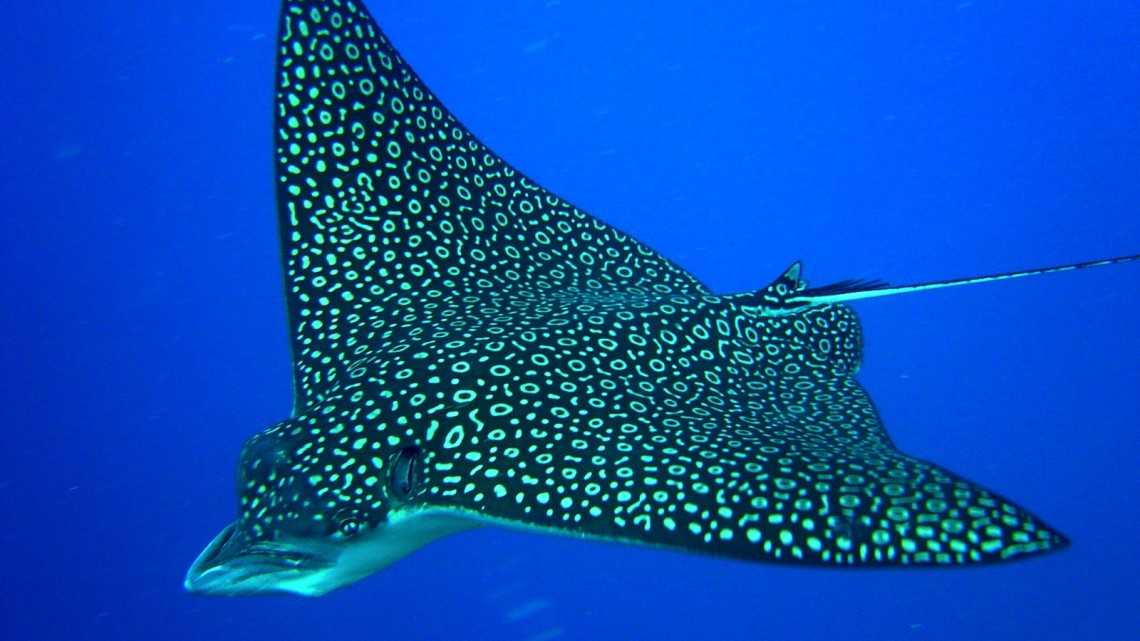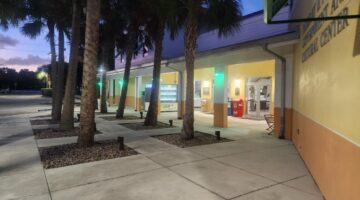IT’S YOUR ENVIRONMENT
Mote Marine scientists seek citizen input for Spotted Eagle Ray research
BY ROBYN G. MAYER
Mote Marine researchers are asking for help from local citizens to contribute to their knowledge of spotted eagle rays. Reports of any sightings benefit the organization’s research on the animal, and the team is particularly interested in Lower Keys sightings at this time of year.
Spotted eagle rays are sighted less frequently or not at all in winter months in the Gulf of Mexico but seem to show up more frequently in the Lower Keys when the temperatures start to drop.
Kim Bassos-Hull, a senior biologist at Mote Marine Laboratory, says “citizen scientists” can prove very valuable to the organization’s pioneering Spotted Eagle Ray conservation program. Local anglers, snorkelers, boaters and divers report sightings of the protected animal, researchers can add to data that the team has been collecting since 2009.
Mote researchers initiated a conservation research project on the life history, reproduction, and population status of the spotted eagle ray (Aetobatus narinari) in 2009. This is the first study ever conducted on the species in the Gulf of Mexico.
Most of the study has so far been conducted in the Tampa, Sarasota Bay, Charlotte Harbor and Pine Island Sound areas.
Citizens can use a form on the Mote Marine website to report sightings.
“If you can get a photograph, that would be great,” Bassos-Hull noted.
The nonprofit has tagged, released and recaptured rays and also uses a pattern recognition software that can identify rays by spot patterns. The study has made 476 observations of 1,140 eagle rays between 2009 and 2013. Most eagle rays are captured in the Sarasota study area between April and October. Bassos-Hull says they likely migrate to the lower keys looking for food and warmer waters.
While the spotted eagle ray was once considered a mostly solitary animal, it has been seen in groups of up to 76 (Redfish Pass). Bassos-Hull said that the study will help the identify behaviors such as if they tend to travel in groups under certain conditions, such as for migration, mating, etc.
Rays are susceptible to boat strikes when they move closer to shore to feed on mollusks and other invertebrates, and have also been injured by fishing line.
It is illegal to fish for or kill this ray in Florida waters but they are not protected under federal laws and international protections are limited as well. They are harvested for food in Cuba and Mexico. The International Union for Conservation of Nature (IUCN), an organization that establishes the conservation status of species worldwide, lists them as near-threatened with a decreasing population trend.
In a research paper Bassos-Hull co-wrote on the ray, she notes that there are many aspects of the animal’s biology and population status that are still unknown. She said in an interview that the study needs to continue for longer before scientists can document more conclusive data. Bassos-Hull said rays are often seen around reefs, where they hunt for bivalves, small fish, shrimp and other bottom-dwelling creatures.
The spotted eagle ray is a meso-predator, which means it is in the middle of the food chain. If the ray declines, it will mean less food for sharks, and a possible overabundance of species upon which the ray feeds.
The Mote website notes that other rays have been found to possess biomedical properties that may ward off cancer. Carl Luer, a senior scientist who initiated and manages a marine biomedical research program of sharks, skates and rays, said he has not included the eagle ray in his studies because it is difficult to get permits to study the protected animal.
Citizens are asked to report such details as location (as detailed as possible, e.g. channel marker, GPS coordinates, mooring hulls, specific reefs), water visibility, cloud cover, water depth, number and size of rays sighted, whether they are tagged, type of ecosystem where sighted, among other factors. Photographs are extremely helpful. Bassos-Hull notes, “This information is important to help determine hotspots for spotted eagle rays in the Florida Keys and areas for future results.”
For more information on the Spotted Eagle Ray and to access the sighting report, visit www.motemarine.org and choose Research Programs from the Research drop-down menu. Scroll down and click on the Spotted Eagle Ray Conservation box.
Mote Marine Laboratory is one of the world’s few remaining private marine research laboratories and, as a nonprofit organization, is funded through federal, state and local grants and through the generosity of individual donors and foundations.
[livemarket market_name="KONK Life LiveMarket" limit=3 category=“” show_signup=0 show_more=0]





No Comment